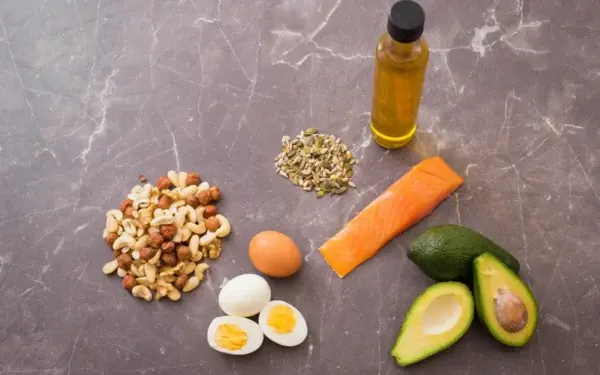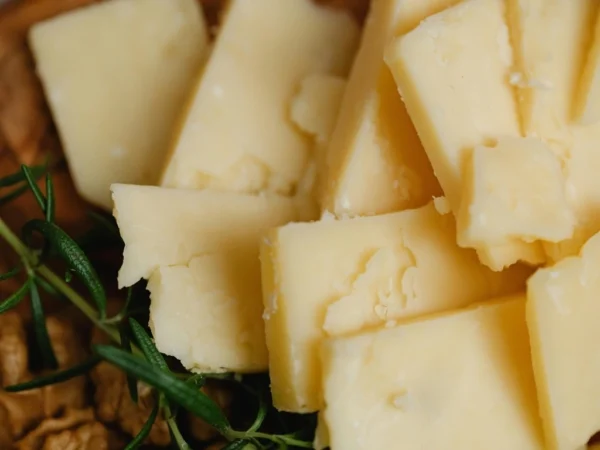When considering what to eat, there is so much information from the media, friends, family, and health care professionals. When asking what you should include in your diet, you won’t go wrong with eating more nutrient-dense foods. These foods carry their weight in nutrients like vitamins and minerals. Why is that important? Some nutrients, vital to our metabolism, digestion, immune health, and reproduction, must be consumed from food.
All foods are made up of three main components: protein, fat, and carbohydrate. These are called macronutrients, and we need them in large amounts because they break down into energy. Within these macronutrient groups, there are some especially beneficial nutrients. Fiber is a carbohydrate that helps regulate your digestion and maintain good gut health. Certain fats, including omega-3 fatty acids, must be consumed from food, and a deficiency in these unsaturated fats can lead to dermatitis, hair loss, and cognitive decline. Protein is made up of several amino acids, nine of which must be consumed from food.
Foods also contain micronutrients including vitamins and minerals. We consume these in smaller amounts, but they are still vital to our body’s metabolism. These micronutrients help your body break down protein, fat, and carbohydrates to make energy. They also help with brain function, wound healing, sense of taste, and more. Selecting the most nutrient-dense foods can help give your body everything it needs. One of the benefits of nutrient-dense foods is that they not only provide your body with needed energy but also necessary nutrients to keep your body running at peak performance.

Energy Dense Foods vs Nutrient Dense Foods
Healthy, nutrient-dense foods are often whole foods like fruits, vegetables, and whole grains. Energy-dense, low-nutrient foods are often more highly processed foods where naturally occurring vitamins and minerals have been removed and sometimes added back. Comparing nutrient-dense food vs energy-dense food is easy to do with the example of cola and strawberries. One bottle of cola is considered an energy-dense drink, having a lot of calories for little nutrient value, while strawberries are a nutrient-dense food. Strawberries provide 16 naturally occurring vitamins and minerals compared with only nine vitamins and minerals in cola. You can consume up to 4 cups of raw strawberries for fewer calories than one bottle of cola. Since cola is a high-calorie, low-nutrient food, you could call it calorie-dense, nutrient-poor, or empty calories. Strawberries, on the other hand, could be considered a low-calorie, nutrient-dense food.
Why Should You Eat Nutrient Dense Foods?
Most people would benefit from a more nutrient-dense diet plan. You may even save money on supplements by eating whole foods that supply you with all the nutrients your body needs. With the cost of groceries rising every day, you want to make sure that all the foods on your grocery list are working hard for you. The great thing about nutrient-dense foods is that they come in all shapes and sizes and fit into any healthy diet, whether you are trying to optimize for weight loss or weight gain. Keep reading for more information on the calories and macronutrient values of some of the most nutrient-dense foods in the world.
Nutrient Dense + High Protein Foods
Tuna
With many varieties of tuna, there are a variety of ways to eat it. Popular in the Mediterranean and Japan for centuries, tuna found its way to the canned food industry in the early 1900s. One can of tuna contains 22 vitamins and minerals in addition to being an excellent source of protein. Although the mercury content of tuna (and other big fish) should be limited in pregnancy, these fish can be a staple in any nutrient-dense diet plan.
How to eat tuna: Albacore tuna is often found steamed and pre-packaged as tuna fish, which can be easily added to salads, wraps, and sandwiches. Yellowfin tuna may be bought as tuna steaks, seasoned and grilled. Bluefin tuna is often used in sushi, thinly sliced and eaten raw on top of rice.
Nutrition Facts: 3oz (85g) provides 109 calories, 20g protein, 2.5g fat, 0g carbohydrate, 0g fiber.
Eggs
For many decades, it was recommended to limit egg consumption due to high cholesterol content thought to lead to elevated LDL or “bad” cholesterol in the bloodstream. Further research has shown the link between cholesterol in eggs and cholesterol in the blood is not straightforward. Eggs are now recommended by the Dietary Guidelines for Americans as well as the dietary guidelines for countries around the world with suggested consumption of about 2-4 eggs per week. One large egg contains at least 20 vitamins and minerals, including a natural source of Vitamin D.
A little about eggs: Two large eggs contain over 50% of the daily recommended amount of choline for adults. Choline helps with memory, mood, and muscle function. Our bodies can make some choline, but we need to consume the majority of it from food.
Nutrition Facts: 2 large eggs (100g) provides 147 calories, 12g protein, 10g fat, 1g carbohydrate, <1g fiber.
Sardines
Thought to be named after the Mediterranean island Sardinia, sardines have been consumed by humans for a long time. In one can of sardines, you will consume 22 vitamins and minerals, including 35% of your recommended daily Calcium and 29% of your recommended daily Vitamin D. So, skip the Calcium and Vitamin D supplements and eat more sardines for good bone health.
How to eat sardines: You can throw them into a seafood pasta and mash them with a fork to incorporate them into your dish.
Nutrition Facts: 1 can (92g) provides 191 calories, 23g protein, 11g fat, 0g carbohydrate, 0g fiber.
Lentils
As one of the world’s oldest crops, lentils have been a part of the human diet since 7000 BC, dating back to southwestern Asia. In addition to being an excellent source of plant protein, these little legumes contain 21 different vitamins and minerals per half cup cooked. The fiber and protein will provide a satisfying fullness with no “empty” calories. They contain polyphenols, a powerful antioxidant, and 15% of your daily iron needs. Lentils have been boasted to protect against diabetes, heart problems, inflammation, and cancer.
How to eat lentils: You’ll often find lentils in a soup or stew, which is where they can really shine with fresh herbs and spices. Add them to a bolognese recipe, a stuffed pepper dish, or pair them with goat cheese over toast to make a nutrient-dense meal.
Nutrition Facts: About ½ cup cooked (100g) provides 116 calories, 9g protein, <1g fat, 20g carbohydrate, 8g fiber.
Nutrient Dense + High Fiber Foods
Leafy Greens
Specifically, leafy greens like kale, collard greens, mustard greens, watercress, and Swiss chard score exceptionally high on the nutrient density scale. This may be contributed to the fact that you can eat a lot of these foods for a very small amount of calories. One cup of kale is only 11 calories and contains 22 vitamins and minerals, including over 25% of your daily requirement for Vitamin C. Leafy greens could be considered a low-calorie, nutrient-dense food, which means you don’t have to worry about any excess calories here.
How to eat kale: Try cooking kale by first removing the stems, chopping into bite-sized pieces, and then sautéing in a pan with olive oil, low-sodium broth, and sliced garlic. Cook for 5-7 minutes on medium-high heat until the kale is wilted, then season to taste with salt, pepper, and lemon juice. Make it your own by adding other flavors you enjoy.
Nutrition Facts: 1 cup raw (25g) provides 11 calories, 1g protein, <1g fat, 1g carbohydrate, 1g fiber.
Berries
Strawberries, blueberries, blackberries, and raspberries show up on just about every nutrient-dense food list available, and there is good reason. Not only do berries score high on their antioxidant properties, but they also contain a healthy amount of fiber, vitamins, and minerals for a relatively low-calorie serving. For one cup of blueberries, you will intake 20 vitamins and minerals and nearly 4g of fiber. With blueberries being 84% water, they are a low-calorie, nutrient-dense food.
A little about blueberries: The phytochemical, anthocyanin, is what makes that dark blue hue of blueberries. This antioxidant has long been studied as a powerhouse chemical, reducing the risk of cardiovascular disease, type 2 diabetes, and protecting the brain from disease. Blueberries are grown in 33 states, and, depending on where you live, their season ranges from April to September.
Nutrition Facts: 1 cup (150g) provides 86 calories, 1g protein, <1g fat, 22g carbohydrate, and 4g fiber.
Prunes
The dried fruit most known to aid in constipation also has surprisingly high amounts of micronutrients and antioxidants. It contains an impressive 22 vitamins and minerals in addition to being the highest-scoring food in an antioxidant analysis (called ORAC) conducted by Tufts University in 1998. For about 100 calories (about 5 prunes), this fruit really packs a punch in the micronutrient department.
A little about prunes: This tasty treat is made from the d’Agen plum, mainly grown in California. They have naturally occurring fiber and sorbitol (a sugar alcohol) which work to make stools softer and easier to pass. They can be eaten alone, as a snack, added to smoothies, sprinkled on top of oatmeal, mixed into a salad, diced and baked into muffins, or stewed into a savory dish. You can even cook and puree prunes to use as a natural sugar substitute. Compared to other foods on this list, prunes may be a high-calorie, nutrient-dense food, meaning they can help fuel your body for daily activities, exercise, or be used as a healthful snack to get you from one meal to the next. You may want to limit it to 1 serving (about 5 prunes) per day to allow your digestive system to adjust to the fiber and sorbitol.
Nutrition Facts: 4-6 prunes (40g) provides 96 calories, 1g protein, <1g fat, 26g carbohydrate, 3g fiber.
Nutrient Dense + Heart Healthy Fat Foods
Almonds
Often noted to be one of the healthiest nuts, almonds have 21 vitamins and minerals, including half of your daily recommended intake of Vitamin E in a one-ounce serving. Research suggests that almonds can do anything from slow signs of aging by reducing wrinkles and improving complexion to preserving cognitive function in old age. From a nutrition perspective, they are an energy-dense, nutrient-dense food. Despite being a more energy-dense food, there are many research studies that show almonds can help achieve weight loss due to their effect on satiety (fullness), an effect of their heart-healthy fat content.
A little about almonds: To harvest almonds, the almond tree is shaken, allowing the almonds to fall off the tree, then the almonds are swept and vacuumed up. They must dry out for several days before being cracked open to reveal the nut that we know as almonds.
Nutrition Facts: 1 ounce (28.35g) of almonds provides 164 calories, 6g protein, 14g fat, 6g carbohydrate, 3.5g fiber.
Avocados
Relatively new to the United States, avocados were originally grown in Central America before they were brought to America. The Hass avocado that we know today was grown and patented in 1935, California. Composed of 22 vitamins and minerals in addition to heart-healthy fatty acids, the avocado is both delicious and nutritious. A single avocado provides 30% of your daily folate and over 30% of your daily fiber. With the high fat and fiber content of avocados, it is no wonder they have been shown to provide satiety for 3-5 hours following a meal.
How to eat avocados: The versatility of avocados makes it a great household staple. You can mash and use as a replacement for mayonnaise on a sandwich or cream in a pasta dish. You can blend it into your favorite smoothie. You can even substitute avocados in place of butter or shortening in muffins.
Nutrition Facts: Half an avocado (100g) provides 167 calories, 2g protein, 15g fat, 9g carbohydrate, 7g fiber.
Chia Seeds
The seed of the Salvia hispanica L. has been used for thousands of years in the diets of Aztecs and Mayas. It is known for its nutritional and therapeutic value. It contains significant amounts of all three macronutrients as well as fiber and heart-healthy fat. The balance of fat and fiber would help satiate even the hungriest person. For a little less than a tablespoon, it packs 18 vitamins and minerals. It contains an impressive amount of both energy and nutrients in a very small package and could be considered a high-calorie, nutrient-dense food. However, it is traditionally eaten in small amounts (less than ¼ cup servings).
How to eat chia seeds: When you mix chia seeds with a liquid and let it sit, the seeds expand and create a soft texture. For this reason, they work well in smoothies or mixed into milk and left to sit in the fridge for a couple of hours before eating. You can also use chia seeds as an egg replacement since they can bind foods together. You can also sprinkle them on top of oatmeal, avocado toast, or yogurt for extra nutritional value in the morning.
Nutrition Facts: About 1 tablespoon (9g) provides 44 calories, 1.5g protein, 3g fat, 4g carbohydrate, 3g fiber.

Summary
Nutrient-dense foods come in all forms, including high-calorie, low-calorie, high-protein, etc. Because no single food can provide all the energy and vital nutrients the human body needs to function, it is important to get a variety of foods in your diet. Whether your goal is to achieve weight loss or weight gain, the benefits of nutrient-dense foods can help people accomplish many health goals while providing a wealth of other benefits, including increased immunity and decreased risk for disease.
References
- The History of Tuna. Live In Home Care. https://www.liveinhomecare.com/the-history-of-tuna/information/
- FoodData Central. U.S. Department of Agriculture. https://fdc.nal.usda.gov
- National Institutes of Health, Office of Dietary Supplements. Choline- Consumer Fact Sheet. NIH. https://ods.od.nih.gov/factsheets/Choline-Consumer/.
- Sardine. New World Encyclopedia. https://www.newworldencyclopedia.org/entry/Sardine.
- Kumar, G., Xu, Baojun. Polyphenol-Rich Lentils and Their Health Promoting Effects. Int J Mol Sci. 2017 Nov 10; 18 (11):2390. doi:10.3390/ijims18112390.
- Nutritional Information. Lentils.org. https://www.lentils.org/health-nutrition/nutritional-information/.
- Kalt W, Cassidy A, Howard LR, Krikorian R, Stull AJ, Tremblay F, Zamora-Ros R. Recent Research on the Health Benefits of Blueberries and Their Anthocyanins. Adv Nutr. 2020 Mar 1;11(2):224-236. doi: 10.1093/advances/nmz065. PMID: 31329250; PMCID: PMC7442370.
- U.S. Highbush Blueberry Council. Seasonality. https://blueberry.org/about-blueberries/seasonality/
- California Prunes. Everything You Need to Know About Dried Prunes. https://californiaprunes.org/articles/health/everything-you-need-to-know-about-dried-prunes/.
- Almonds: From Flowering to Harvesting to Processing – A Year in the Life. Blue Diamond Growers. https://www.bluediamond.com/blog/almonds-from-flowering-to-harvesting-to-processing-a-year-in-the-life/.
- California Almonds. Beauty Benefits: A new skin health study. March 17, 2021. https://www.almonds.com/why-almonds/almond-living-magazine/beauty-benefits-new-wrinkle-study
- Rybak I, Carrington AE, Dhaliwal S, Hasan A, Wu H, Burney W, Maloh J, Sivamani RK. Prospective Randomized Controlled Trial on the Effects of Almonds on Facial Wrinkles and Pigmentation. Nutrients. 2021; 13(3):785. https://doi.org/10.3390/nu13030785
- California Avocado Commission. The History of California Avocados. Jul 23, 2020. https://californiaavocado.com/avocado101/the-history-of-california-avocados/
- Marcinek K, Krejpcio Z. Chia seeds (Salvia hispanica): health promoting properties and therapeutic applications – a review. Roczniki Państwowego Zakładu Higieny / Annals of the National Institute of Hygiene. 2017;68(2):123-129.













